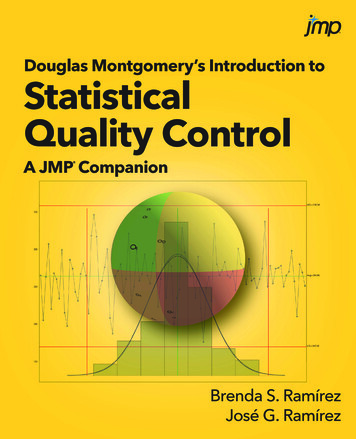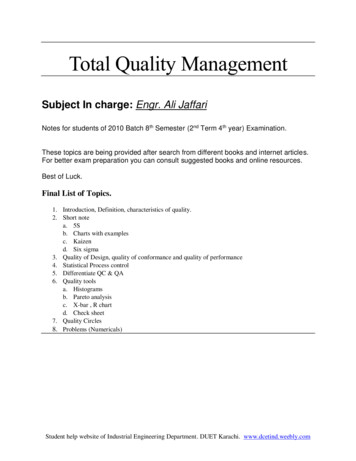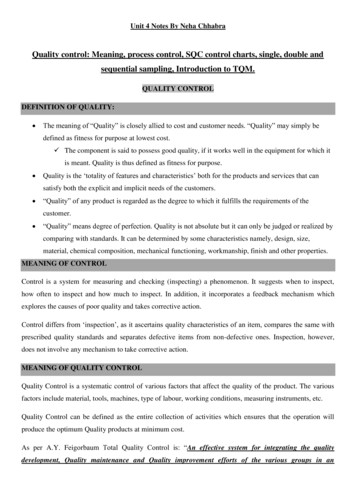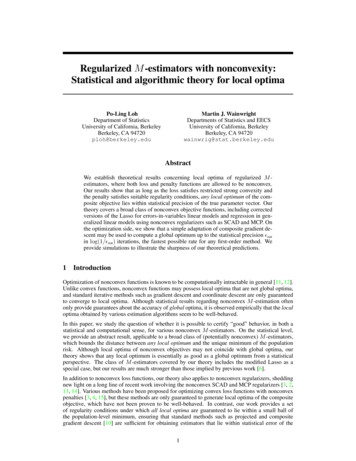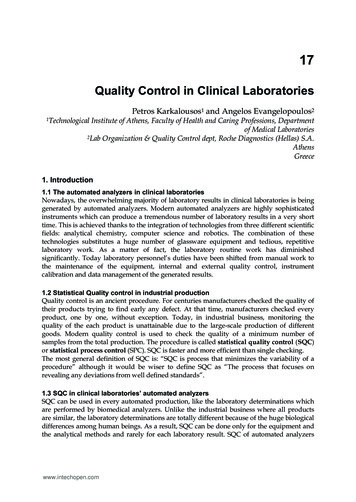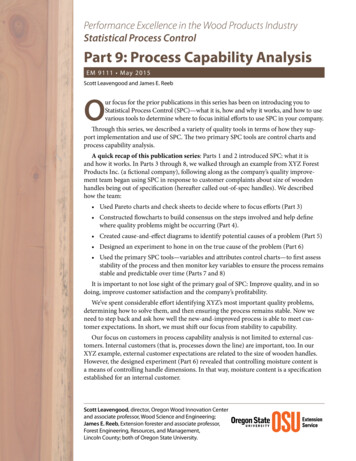
Transcription
Performance Excellence in the Wood Products IndustryStatistical Process ControlPart 9: Process Capability AnalysisEM 9111 M ay 2015Scott Leavengood and James E. ReebOur focus for the prior publications in this series has been on introducing you toStatistical Process Control (SPC)—what it is, how and why it works, and how to usevarious tools to determine where to focus initial efforts to use SPC in your company.Through this series, we described a variety of quality tools in terms of how they support implementation and use of SPC. The two primary SPC tools are control charts andprocess capability analysis.A quick recap of this publication series: Parts 1 and 2 introduced SPC: what it isand how it works. In Parts 3 through 8, we walked through an example from XYZ ForestProducts Inc. (a fictional company), following along as the company’s quality improvement team began using SPC in response to customer complaints about size of woodenhandles being out of specification (hereafter called out-of-spec handles). We describedhow the team: Used Pareto charts and check sheets to decide where to focus efforts (Part 3) Constructed flowcharts to build consensus on the steps involved and help definewhere quality problems might be occurring (Part 4). Created cause-and-effect diagrams to identify potential causes of a problem (Part 5) Designed an experiment to hone in on the true cause of the problem (Part 6) Used the primary SPC tools—variables and attributes control charts—to first assessstability of the process and then monitor key variables to ensure the process remainsstable and predictable over time (Parts 7 and 8)It is important to not lose sight of the primary goal of SPC: Improve quality, and in sodoing, improve customer satisfaction and the company’s profitability.We’ve spent considerable effort identifying XYZ’s most important quality problems,determining how to solve them, and then ensuring the process remains stable. Now weneed to step back and ask how well the new-and-improved process is able to meet customer expectations. In short, we must shift our focus from stability to capability.Our focus on customers in process capability analysis is not limited to external customers. Internal customers (that is, processes down the line) are important, too. In ourXYZ example, external customer expectations are related to the size of wooden handles.However, the designed experiment (Part 6) revealed that controlling moisture content isa means of controlling handle dimensions. In that way, moisture content is a specificationestablished for an internal customer.Scott Leavengood, director, Oregon Wood Innovation Centerand associate professor, Wood Science and Engineering;James E. Reeb, Extension forester and associate professor,Forest Engineering, Resources, and Management,Lincoln County; both of Oregon State University.
Does stability equal capability?In Part 7, we developed control charts for data on wood moisture content. Withevidence that the process is in control (stable), we can have confidence that our estimates of process centering and variability are reliable. We have reasonable assurancethat the process is stable. But does that mean the process is capable of meeting customer expectations? Unfortunately, the answer is no.Stability reflects how the process is performing; capability reflects the customer’s desires for the products. Said another way, stability is related to the “voice of theprocess” and capability is related to the “voice of the customer.” The two are generallyunrelated.For example, a customer may specify that moisture content must be an average of6% 1%. To give an extreme example, if we gather data, construct a variables controlchart (see Part 7), and find our process is stable at an average moisture content of 10% 5%, we have assurance of stability. But clearly the process is not capable. It is centered at far too high of a moisture content with far too much variability to meet thespecifications.But how bad is it? How much defective product can we expect to produce, andwhat does that cost the company? How much could we reduce the defect rate, andthus the costs, if we were able to reduce variability from 5% to 3%? Process capabilityanalysis enables us to answer these questions.Process capability analysisWhy is processcapability analysisimportant?Some customers requiresuppliers to meet or exceedspecific process capabilityindices.For example, a customermight say they require suppliers to provide evidencethat their capability indexfor a certain parameter(e.g., moisture content,thickness) was at least 1.33.In such cases, you mustmeet these criteria or losea customer. Suddenly, youare motivated to learn howto calculate and interpretcapability indices!2Continuing with our XYZ example, remember that discussion in Part7: Variables Control Charts ended with the team assuming that the processexhibited control at an average moisture content of 6.5% and an averagerange of 2.6%. Can the team now be confident that the size-out-of-specproblem will go away? No. A stable process is not necessarily capable.In fact, the goal of the designed experiment (Part 6) was to controlmoisture content at 6%. The process is already slightly off target. But whatis the impact of being slightly off target? Is it worth investing the effortto bring the process on target at 6%? Also, is an average range of 2.6%acceptable? What is an acceptable level of variability?We now know we can control moisture content at 6.5% with a rangeof 2.6%. Using the R/d2 formula presented in Part 7, we can estimate theprocess standard deviation. Since d2 (a table value) for samples of size fiveis 2.326, our estimate of standard deviation for this process is about 1.12%(2.6/2.326). And given what we know about the normal distribution, wecan expect that more than 99% of moisture content readings should fallbetween the mean plus and minus three standard deviations (6.5 3 1.12,or 6.5 3.4), which is from about 3% to 10% moisture content.So to determine the acceptable level of variability, we could conductanother designed experiment with those moisture content values for birchand poplar and measure the number of out-of-spec handles, as before. Ifthe number of out-of-spec handles is acceptable, we would continue tomonitor the process to ensure it stays at these x and R values.
However, for this discussion, let’s assume the experiment indicates this target valueand variability are too high and result in excessive out-of-spec product. Further, theexperiment confirms that we need to maintain specifications of 4% to 8% (6% 2%)moisture content. To describe the current capability of the process, we need somesimple way to compare the variability of our process relative to the specifications.Process capability analysis does just that with a few simple ratios.Process capability: A quick visual explanationFigure 1 shows normal curves for two process distributions. LSL and USL are thelower specification limit and upper specification limit, respectively. The lower, widerdistribution is the curve for XYZ’s current process (average of 6.5% 3.4% moisturecontent)1. The taller, narrower distribution represents the specifications (centered at6% 2% moisture content). The shaded area represents defects (material beyond thespecifications).From this graph, we can see that by being off target and having excessive variability,XYZ is producing a significant amount of material beyond the specifications, specifically the upper specification. A graph like this can help illustrate the concepts, butfrom a practical standpoint, we need to quantify the relationship between the spreadof the process and the spread of the specifications. We can do this by using capabilityindices.Figure 1. Effect of process standard deviation and centering on the defect rate.Recall that the average range (R) was 2.6%. For samples of size five, this equates to a process standard deviation of1.12 (R/d2, where d2 is a table value that varies with sample size). Therefore, the distribution is from the mean plus andminus three standard deviations, or 6.5% 3.4% moisture content.13
Capability indicesThe first capability index we will discuss is Cp, which is calculated as:where σ is the process standard deviation and the (hat or caret) symbol over itmeans “estimate.” Recall that σ is the true standard deviation for a normally distributedvariable, and generally the best we can do is estimate it by sampling the process. Thevalue 6 is the total width of process variability (that is, plus and minus three standarddeviations). Therefore, Cp is a ratio of the specification width to total process width.Given that our specification for moisture content is 6% 2%, the LSL is 4% and theUSL is 8%. Because the estimate of R was 2.6% and the table value for d2 is 2.326, is1.12 (2.6/2.326) and Cp is:What does this mean? In simple terms, the higher the Cp value the better. A Cpequal to 1.0 means we are exactly on the specifications. A Cp less than 1.0 indicatesthat process variability is higher than the specification width, and therefore producing a substantial amount of defective material. Later in this publication, we’ll be moreprecise about how much defective material is produced. In the XYZ example, Cp is lessthan 1.0 so we know that process variability is too high and, therefore, the process isnot capable of meeting the specifications.Cp is a simple ratio that is relatively easy to calculate. Its primary limitation is thatit does not account for process centering relative to the target. Theoretically, a manufacturing process could be centered far away from the target, perhaps even producing100% defective product. Yet if the process variability were low, Cp would indicateeverything was okay.To account for process variability and centering relative to the target, we useanother process capability index, Cpk. The formula for Cpk is:where Cpl and Cpu are the lower and upper process capability indices, respectively,relative to the process average; is our estimate of the process average; and min indicates that Cpk is the minimum (lesser or worst-case) of Cpl and Cpu.To calculate Cpk, we use as calculated above, and we use x as . Because our estimate of x is 6.5% moisture content, Cpk is then:Cpk is interpreted much the same as Cp, Below 1.0 is bad and above 1.0 is good.However, Cpk provides a bit more information. If Cpl and Cpu are equal, we know theprocess is on target. And when the process is on target, Cp and Cpk are the same.4
In this case, because Cpl and Cpu are not equal, we know the process is off center.Specifically, because Cpu is lower than Cpl, we know the process is centered too close tothe USL. Therefore, excessive defects are produced above the USL, as seen in Figure1. We can use the normal distribution to estimate the percentage of defective product(see Estimating defect rates, below).What if we adjust the process to put it on target? In other words, what if we shiftthe process center from 6.5% to 6%? Because Cp does not account for process centering, it would not be affected. Cpk, however, would increase from 0.45 to 0.60.Remember, Cp and Cpk are the same when a process is on center.Perhaps more importantly, what if we also engage in continuous process improvement activities and reduce the average range (R) from 2.6 to 2.0? Now our estimateof Cpk (and Cp) would be 0.77. Because it is still below 1.0, we might ask: What does Rneed to be to attain a Cpk of 1.0? We need a process that operates in control at an average range (R) of about 1.55 to achieve a Cpk of 1.0 for this process.Some customers stipulate Cp or Cpk values for their suppliers. However, for internalcustomers, you might find it difficult to generate much excitement related to increasing a process capability index from 0.45 to 1.0. After all, the language of business ismoney and these indices don’t directly give any idea of what this means in terms ofdefect rates and, therefore, the cost of poor quality. For this, we need to delve a bitmore into statistics.Estimating defect ratesWhat are the practical implications of these capability indices? For example, if wemove from a Cpk of 0.45 to 0.77, what does that mean for the company’s defect rate,costs, and profitability? This is an advanced, but critical, topic.To estimate the defect rate, we must know something about how the data are distributed. In this case, we need to know how the moisture content data are distributed.For example, if we collect a few hundred readings and plot a histogram (see Part 2),would the data appear to be normally distributed as shown in Figure 1? Or would thedata be skewed such that most values are on the lower end and there is a long tail outto the right for higher moisture content values?Unless you have a statistician on staff (or happen to be one yourself!), it canbecome very complex to determine the distribution that best fits the data and then usethat information to estimate defect rates. Therefore, the most common approach is tosimply assume the data are normally distributed. All we need to draw normal curvesis the mean and standard deviation—and we have estimates of those values from ourcontrol charts.Let’s return to the XYZ example. Given that the process is operating at an averagemoisture content of 6.5% 3.4% (average range of 2.6%), Cpk is 0.45. However, thespecifications are 6% 2%. In Figure 1, the shaded area beyond the USL (8%) is fairlylarge. But how large? If we assume moisture content is normally distributed, what percentage of handles can we expect to have a moisture content above 8%?5
To obtain this estimate, we again turn to tables that are typically found in theappendix of quality control textbooks. Look for a table of area under the standardnormal curve. What does standard normal curve mean? Since there are infinite combinations of means and standard deviations, we would need an infinite number oftables of normal distributions. It’s not possible to list them all in a textbook. Therefore,we must standardize our data so it can be represented by a normal distribution with amean of zero and standard deviation of one. To do this, we calculate a z statistic:where X is the value of interest, and and are, as before, estimates of the meanand standard deviation of the process. The z value tells us how many standard deviations above the average a value is.For example, to calculate the percentage of handles that will have a moisture contentgreater than 8% (the shaded area on the right of Figure 1), we calculate the z value as:Then we refer to a table of areas under the standard normal curve and look up thevalue for 1.342, which is 0.9099. This value means that 90.99% of the values will bebelow 1.34 on the standard normal curve, which is 8% moisture content in our example. The table lists the area to the left of the value (below).However, we’re interested in the area to the right—the values greater than 8%. Sincethe area under the normal curve is 1.0, simply subtract the table value from 1. In thiscase, the result is 1 - 0.9099, or 0.09. So we expect about 9% of the moisture contentreadings to be greater than the USL of 8%.Is this the estimate of the defect rate? Not quite. Remember: There is also a lowerspecification. To get that value, using the LSL of 4%, we estimate z as:Because we are interested in the area (percentage) to the left of this value, we canread the value directly from the table as 0.013, or about 1.3%.Therefore, the total estimate of defects is 9% 1.3%, or approximately 10.3%.You can do this in spreadsheet software as well. For the example here, you would enter NORMDIST(8, 6.5, 1.12, 1).The final “1” in the formula is to get the cumulative value; that is, the area under the normal curve.26
Cost of defectsWhat does this defect rate mean in terms of cost? To know that, we need to connectmoisture content to the costs of rejecting or reworking handles. In Part 3, we learnedthat XYZ has an average scrap and rework cost of 12 for out-of-spec handles. Again,without hard data, we’ll have to make some assumptions. For this example, we’llassume that moisture content beyond the specifications results in out-of-spec handles(as demonstrated in the designed experiment).If XYZ operates 5 days per week, that equates to 21.67 days per month. If thecompany produces 5,000 handles per day, that is approximately 108,000 handles permonth. At the 10.3% defect rate, about 11,000 handles would need to be scrapped orreworked every month. At an average scrap/rework cost of 12 each, the total is justover 130,000 per month.This is the estimated defect rate and accompanying cost given an average moisturecontent of 6.5% 3.4% (average range of 2.6%), which equates to a Cpk of 0.45.What if the XYZ team shifts the process to be on target at 6% moisture content withan average range (R) of 2.0, so that the new Cpk is 0.77? (Note: Of course, the teamcould aim for a Cpk of 1.0 or even 2.0. However, there’s wisdom in setting realistic goalsfor initial quality improvement efforts, and then trying to exceed those goals. As thesaying goes, under-promise and over-deliver).With an R of 2.0, the estimate of standard deviation is now 0.86 (2.0/2.326). And zvalues would be:The table values for areas under the normal curve for these z values are about 0.01each, so the new defect rate is about 2%. Monthly scrap/rework costs would be about 26,000. That’s a reduction in cost of more than 100,000 per month!What if XYZ further improves the process to be on target at a Cpk of 1.0; that is, at6% moisture content with an R of 1.55 (standard deviation of 0.67)? The defect ratewould drop to 0.3% (that’s 3 in 1,000 vs. the 1 in 10 we have now), and the monthlycosts would be about 3500.7
SPC: SummaryIf you want to convince managers at your company to invest in quality training soyou can effectively pursue quality improvement, we recommend following the processoutlined in this publication series: Parts 1 and 2: Introduce company personnel to SPC: what it is and how and whyit works. Part 3: Talk with customers about quality issues. Use Pareto charts and checksheets to decide where to focus initial quality improvement efforts. Devote sometime to determine what the specific defect categories cost in terms of reject fromcustomers, or internally in terms of scrap, rework, and downgrade. Part 4: Construct flowcharts to build consensus on the steps involved and helpdefine where in the process quality problems might be occurring. Part 5: Create cause-and-effect diagrams to identify potential root causes of thetop quality issues. Part 6: Conduct designed experiments to hone in on the true cause of theproblem and understand how key process variables (e.g., moisture content,species, tooling) affect quality. Use designed experiments to establish optimalprocess settings. Parts 7 and 8: Use control charts to determine if the process is stable. Whencharts demonstrate stability, estimate centering and variability of the process. Part 9: Use process capability analysis to assess whether the process is capable ofmeeting specifications. Estimate potential savings due to quality improvement.The bottom line is, well, still the bottom line. You are unlikely to find many managers who will get excited when you request funds to conduct quality improvementprojects with a goal of reducing the standard deviation from 1.12 to 0.86 or increasingthe Cpk from 0.45 to 0.77. These values are important, but you need to connect themto costs and profitability. Managers will likely pay attention if you are able to explain(and document) that a quality improvement project will reduce costs by 100,000 permonth due to a reduced scrap/rework rate, as in the XYZ example.Of course, you’ll have to be prepared to justify your cost savings estimates. Thispublication series provides information you can use to prepare to present conceptsbacked with data and facts. Spend time quantifying what specific types of defectscost the company. In the wood products industry, we sometimes assume that scrap,rework, and downgrade are insignificant given the relatively low cost of small woodcomponents. However, when you consider the volume produced in a day, it doesn’ttake long for even relatively low defect rates to result in significant costs to the company, as we’ve tried to demonstrate here.And finally, remember this advice: “Total quality management is a journey, not adestination.” (Thomas H. Berry, 1990. Managing the Total Quality Transformation).Quality improvement is a continuous pursuit that requires proactively seekingcustomer input, improving processes, and then repeating those steps in an effort toreduce variability and thereby improve quality, improve customer satisfaction, andimprove profitability.8
For more informationThe Oregon Wood Innovation Center website provides common table values for SPC:http://owic.oregonstate.edu/spcThe listing for the SPC Part 7 publication (EM 9109) in the OSU Extension Catalogalso includes a supplemental spreadsheet file that includes data and a chart forcapability analysis (see tab labeled state.edu/em9109Berry, Thomas H. 1990. Managing the Total Quality Transformation. New York, NY:McGraw-Hill.Brassard, M., and D. Ritter. 2010. The Memory Jogger II: A Pocket Guide of Tools forContinuous Improvement & Effective Planning. Methuen, MA: Goal/QPC.http://www.goalqpc.comGrant, E.L., and R.S. Leavenworth. 1996. Statistical Quality Control (7th edition). NewYork, NY: McGraw-Hill.Montgomery, D.C. 2012. An Introduction to Statistical Quality Control (7th edition).New York, NY: John Wiley & Sons.Western Electric Company Inc. 1956. Statistical Quality Control Handbook.Milwaukee, WI: Quality Press.About this seriesPublications in the Performance Excellence in the Wood Products Industryseries address topics related to wood technology, marketing and businessmanagement, production management, quality and process control, andoperations research.For a complete list of titles, visit the Oregon State University ExtensionCatalog and search for “performance e.edu/Trade-name products and services are mentioned as illustrations only. This does not mean that the Oregon State UniversityExtension Service either endorses these products and services or intends to discriminate against products and services notmentioned. 2015 Oregon State University.Extension work is a cooperative program of Oregon State University, the U.S. Department of Agriculture, and Oregoncounties. Oregon State University Extension Service offers educational programs, activities, and materials withoutdiscrimination based on age, color, disability, familial or parental status, gender identity or expression, genetic information,marital status, national origin, political beliefs, race, religion, reprisal, sex, sexual orientation, veteran’s status, or because allor a part of an individual’s income is derived from any public assistance program. Oregon State University Extension Serviceis an AA/EOE/Veterans/Disabled.Published May 2015.
Statistical Process Control Part 9: Process Capability Analysis O ur focus for the prior publications in this series has been on introducing you to Statistical Process Control (SPC)—what it is, how and why it works, and how to use various tools to determine w

